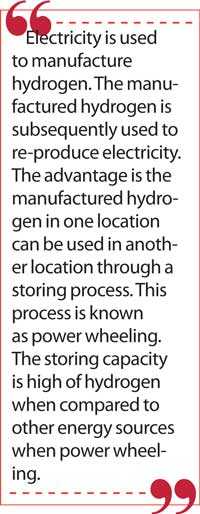Tuesday Dec 09, 2025
Tuesday Dec 09, 2025
Tuesday, 2 April 2019 00:00 - - {{hitsCtrl.values.hits}}

As the future of the longstanding core-relationship between the financial industry especially the non-banking financial industry (NBFI) and the motor vehicle-based leasing industry is highly questionable, it’s the right time to look for other alternative leasing options in the financial market.

The loan growth of the Sri Lankan NBFI has slowed down considerably since end-2015 with tightened regulation on vehicle financing and increased tariffs on duties of vehicle importation. Loan growth year-on-year had already slowed to 9% by end-2018 from a high of 31% in 2015, due to the imposition of tighter loan-to-value ratios on vehicle-financing by the Central Bank of Sri Lanka (CBSL).
Having this in mind I have spoken to a few experts in different fields and one of them really convinced me. He is Athula Samarasinghe, a retired military officer who has joined the company of Prof. Chandima Gomes, Dr. Ananda Malawatantri, and Eng. Gamini Senanayaka in trying to address our country’s debt-riddled status through energy security.
Debt-riddled status through energy security! What’s that? That too stuck my mind. Apart from my main intention of finding alternative tools to the non-banking financial industry for its sustainability, finding the ways to narrow down the country’s current account deficit which in return influences the debt riddled status of the country in positive means too fascinated me. Having this in mind I opened today’s (19 March) Daily FT only to find out that the power cuts are on the cards due to the prevailing dry weather conditions and an unexpected breakdown of the Norochcholai coal power plant. Now I have three in a row. Addressing alternate tools for the financial industry, debt-riddled status through energy security and now unscheduled power cuts.
A way out for Sri Lanka
Well, a way out for Sri Lanka. I was inquisitive. Athula mentioned to me about Hydrogen (H2) as an alternative energy source. As mentioned in reliable sources, hydrogen fuel is a zero-emission fuel when burned with oxygen. It can be used in electrochemical cells or internal combustion engines to power vehicles or electric devices. It has begun to be used in commercial fuel cell vehicles such as passenger cars and has been used in fuel cell buses for many years. In another research it is disclosed by the year 2050 there will be a hydrogen demand of over 42 million metric tons or 45 billion gallon gasoline equivalent (GGE) in the United States of America alone which can fuel up 342 million light-duty vehicles for 51 × 1011 miles (82 × 1011 km) travel per year.
It can be used in electrochemical cells or internal combustion engines to power vehicles or electric devices. It has begun to be used in commercial fuel cell vehicles such as passenger cars, and has been used in fuel cell buses for many years. Coming back to Athula, I am told a discussion between Prof. Gomes and Athula during a leisure trip in trying to improve the quality of air inside air-conditioned environments had trigged the topic of Hydrogen. Inspired by the revelations made by Prof. Gomes, Athula researched the topic. He then approached Dr. Mallawatantri an environmental scientist who spurred them to solve an environmental issue while striving to attain energy security status for Sri Lanka. Consequently, they formed an entity dedicated to the mentioned purpose.
This entity set themselves certain goals. Mainly, five main goals in order to establish the concept here in Sri Lanka. In addressing these goals, they realised the logical attainment of the undermentioned goals follows a strict order and will compliment energy security in the long run.
Goal 1 – Make hydrogen production economically viable (develop hydrogen as a commercial proposition)
Goal 2 – Capitalise on off peak power (generate hydrogen to balance power grid)
Goal 3 – Induce the use of hydrogen through the transportation sector (Use hydrogen as a fuel)
Goal 4 – Power wheeling clean energy through the national grid to produce hydrogen (encourage clean energy generation)
Goal 5 – Reduction of foreign exchange expenditure on crude oil (uplift the economy of Sri Lanka through energy security).
In trying to address goals Goal 1 and 3, they set themselves some specifications which they are to meet if the project is to commence.
Need 1 – Availability at convenient sites (availability levels of gasoline).
Need 2 – Speed of refuelling (speed of refuelling of gasoline).
Need 3 – Wear and tear (wear and tear to be less than a gasoline driven vehicle).
Need 4 – Cost effectiveness (should be a cheaper alternative to gasoline).
Need 5 – Safety (should be higher or equivalent to gasoline).
Need 6 – Government will (should be convinced of the short and long term benefits). 
As per the needs analysis, they went on to conduct a feasibility study involving three-wheelers. The desk review has generated encouraging results. The first simulation study conducted by them involved converting existing three-wheelers into hydrogen. According to them, there are 600,000 three-wheelers in the Western Province. If those could be converted to hydrogen, the balance of trade could reduce by around 40% which is an eye-opener to all of us.
Based on the findings given by Athula, it is suggested to design a product or two by the NBFI to cater to the need. This aspect will certainly stabilise our current account deficit in the long run. Therefore the Government can consider generous tax concessions on such products.
Discussing further, I am informed in 2020 Japan is planning to set up a hydrogen village during the Olympic Games and also by 2040 the developing world will switch to hydrogen as the main source of energy. The cost of manufacturing hydrogen mainly goes against electricity.
Electricity is used to manufacture hydrogen. The manufactured hydrogen is subsequently used to re-produce electricity. The advantage is the manufactured hydrogen in one location can be used in another location through a storing process. This process is known as power wheeling. The storing capacity is high of hydrogen when compared to other energy sources when power wheeling. The power generated through wind, solar coal, and diesel can be used to manufacture hydrogen. The power generated through solar and wind is treated as low quality as they are not in a position to dispatch power on demand. During some seasons of the year, the power could generate in high volumes but not constantly which means the generation of power is seasonal. The generated high volumes can store in hydrogen form to use afterward in a centralised place. The base power which is the minimum requirement of power can be pumped into the national grid at any given time by using stored hydrogen energy.
Research shows that hydrogen will be a key player in storing energy that is wasted at the generation stage in large-scale power grids by off-peak diversion to dummy loads. The study concludes that hydrogen has a promising future to be a highly feasible energy carrier and energy source itself at the consumer level. Unlike in coal power which needs around two weeks to start up and also to shut down, hydrogen power could be used instantly. To power hydrogen energy, wind power could be used as the main source. It is said as per another US-backed research project wind power in Sri Lanka is sufficient enough to fuel the entire energy requirement of the country. It is estimated, a cost of around $ 1.2 million is required to set-up a 10-megawatt wind power plant. However, with a certainly reasonable hypothesis and as per the present tariff the breakeven period of this investment is only six years. Once the plant is commissioned for operations it is only the maintenance that has to be looked in.
In a research conducted by the University of Fribourg, Switzerland it is said vehicles can be run either by connecting them to a continuous supply of energy or by storing energy on board. The transport of people and goods is a socioeconomic reality that will surely increase in the coming years. It should be safe, economical and reasonably clean. Hydrogen would be ideal as a synthetic fuel because it is lightweight, highly abundant and its oxidation product (water). It is also environmentally benign. With a few concerns, they too recommend the best substitution for the existing usage of fuel is hydrogen.
Substantial health and environmental benefits
The other resource personnel who contributed facts to this article the UK based Prasad Wijegoonwardena says hydrogen as an energy source enhances energy security, eliminates importing fuel, and limits exposure to volatile world commodity markets. He further says substantial health and environmental benefits such as the elimination of carbon dioxide emissions, other greenhouse gas pollution, reduces smog and other harmful particulate emissions that cause health issue are also on record. Additionally, other areas of positive aspects such as, low operating and maintenance costs, and provides power to remote areas with no electricity grid are also existing.
He further says hydrogen is one of the most abundant elements in the universe. Hydrogen makes up over 90% of the sun’s composition. It is also the lightest basic element (atomic weight: 1.008) in the periodic table. However, hydrogen has a higher energy density per given mass than most carbon-based commodities (three times that of gasoline, over two times that of natural gas). While hydrogen is not found naturally in its pure molecular form on earth, it is found in combination with other elements – most commonly in water (H2O), in organic compounds, and in hydrocarbon energy molecules (petroleum, coal, natural gas). The energy contained within hydrogen molecules can be converted to electricity through an electrochemical process in fuel cells, with only pure oxygen being emitted as a by-product. Considering the knowledge and contacts he has built internationally, he is of the view hydrogen is the best option for Sri Lanka to face the uncertainties in local energy supply and global economic conditions.
Considering the views of these two experts and other findings on the subject, it is suggested to consider the formation of a platform to launch this energy giant to address the country’s power and energy shortage mainly. Once it is established the current account deficit of the country will stabilise to a great extent. Under the given state of affairs, the non-banking financial industry should be prepared to capitalise on the circumstances by creating products to accommodate this gigantic economy changer.
(The writer, is the founder of Infornets, an organisation which is formed with the intention of sharing credit related information and financial knowledge to less-informed people, locally and internationally. He counts 35 years of experience in the non-banking financial industry of Sri Lanka. He is a former CEO/General Manager of a non-bank financial institution. He holds a Master Degree in Business Administration from the UK. He is a board member of the National Science and Technology commission (NASTEC). He is a Member of Institute of Management of Sri Lanka and an Associate member of Sri Lanka Association of Advancement of Science. He can be reached via [email protected] or www.infornets.com.)